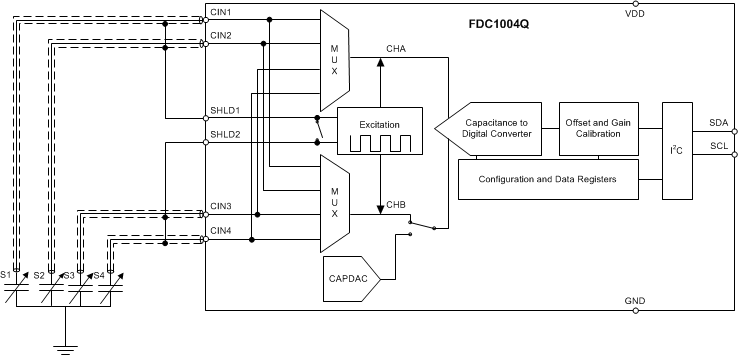SNOSCZ4A April 2015 – October 2024 FDC1004-Q1
PRODUCTION DATA
- 1
- 1 Features
- 2 Applications
- 3 Description
- 4 Pin Configuration and Functions
- 5 Specifications
- 6 Detailed Description
- 7 Applications and Implementation
- 8 Device and Documentation Support
- 9 Revision History
- 10Mechanical, Packaging, and Orderable Information
Package Options
Mechanical Data (Package|Pins)
- DGS|10
Thermal pad, mechanical data (Package|Pins)
Orderable Information
6.4.2 Differential Measurement
When the FDC1004-Q1 is used for interfacing to a differential capacitive sensor, each of the two input capacitances must be less than 115pF. In this configuration the CAPDAC is disabled. Keep the absolute value of the difference between the two input capacitances below 15pF to avoid introducing errors in the measurement. In differential measurements, SHLD1 is assigned to CHn and SHLD2 is assigned to CHm, where n < m. For instance in the measurement CIN1 – CIN2, where CHA = CIN1 and CHB = CIN2 (see Table 6-4), SHDL1 is assigned to CIN1 and SHDL2 is to CIN2. Differential sensors made with S1 versus S3 and S2 versus S4 are shown below in Figure 6-3. S1 and S2 are alternatively connected to CHA and the S3 and S4 are alternatively connected to CHB, the shield signals are connected as explained in previous paragraph. The FDC1004-Q1 performs a differential measurement when CHB field of the Measurements Configuration Registers (refer to Table 6-4) is less than to b100.
This configuration is very useful in applications where environment conditions need to be tracked. The differential measurement between the main electrode and the environment electrode makes the measurement independent of the environment conditions.
 Figure 6-3 Differential Configuration
Figure 6-3 Differential Configuration